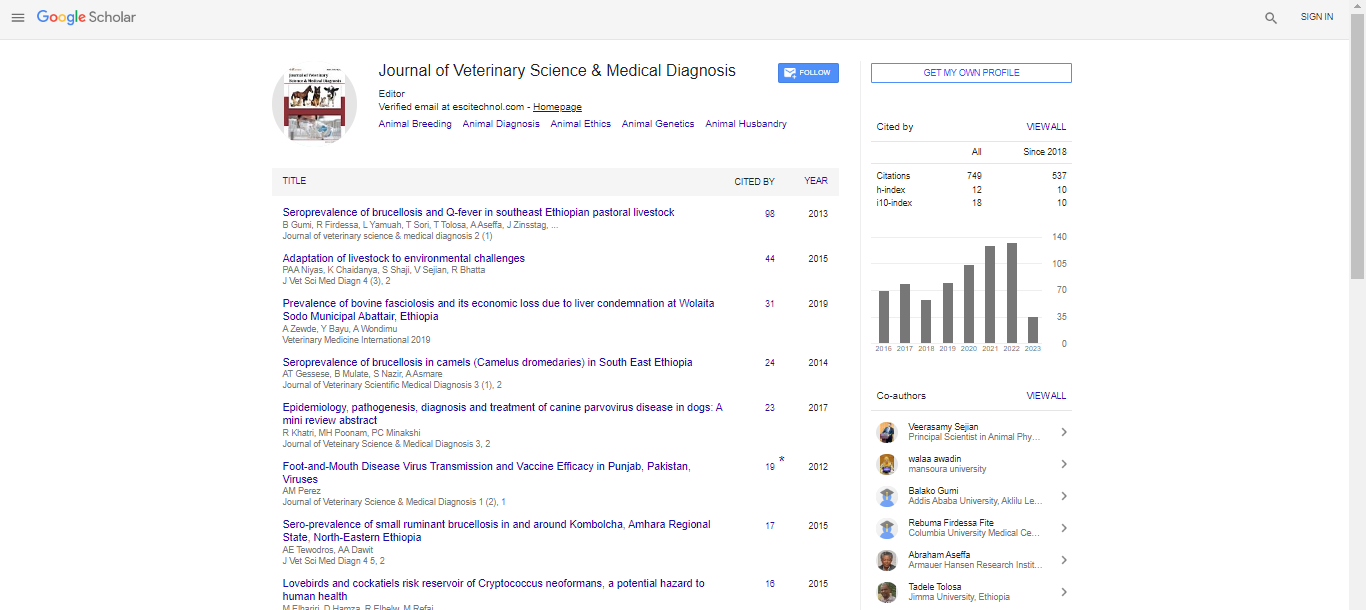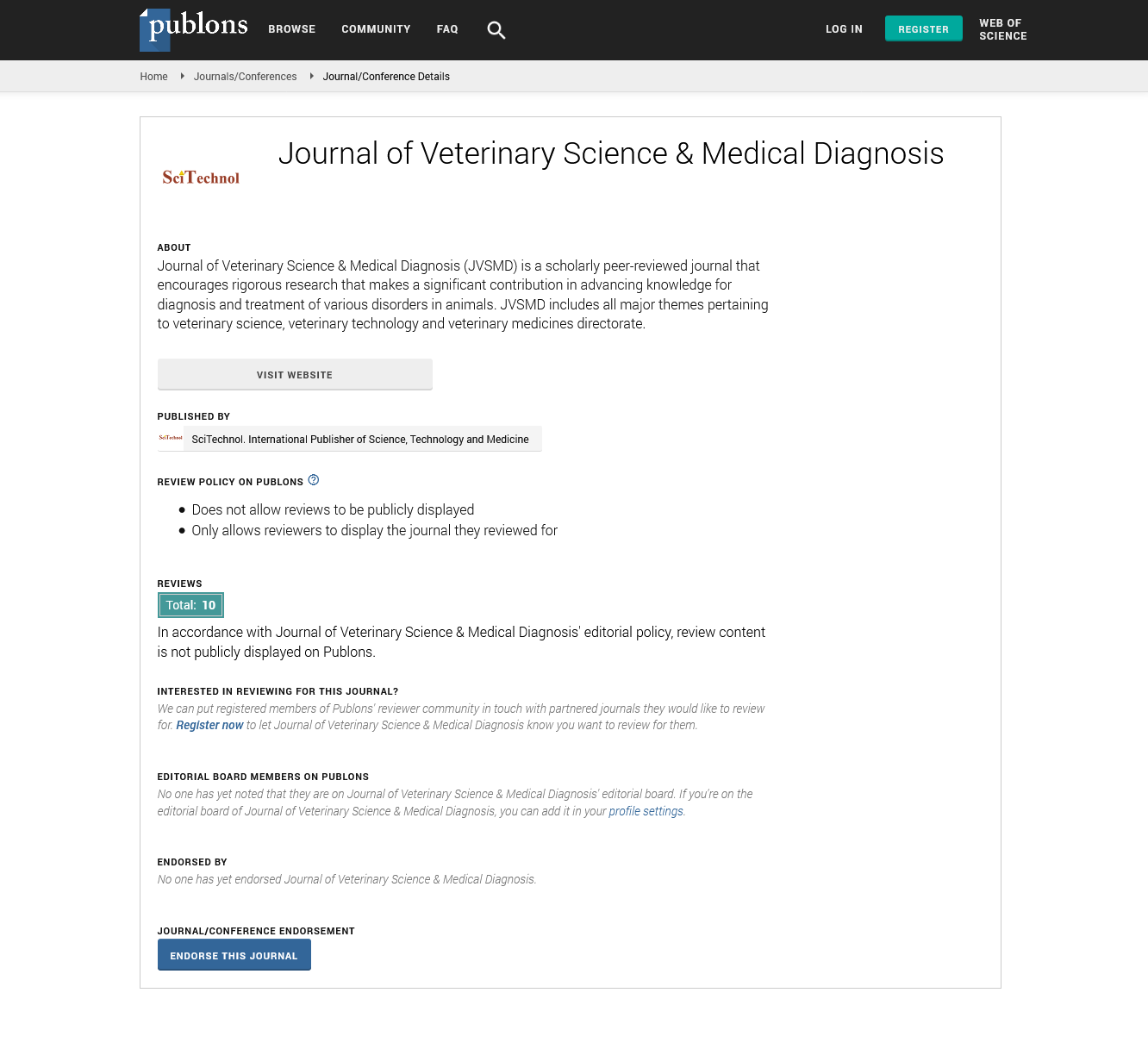Commentary, J Vet Sci Med Diagn Vol: 12 Issue: 1
Immunization Strategies for Livestock Health and Disease Prevention
Timothee Vergne*
Department of Veterinary Pathology, National Veterinary School of Toulouse, Toulouse, France
*Corresponding Author: Timothee Vergne
Department of Veterinary Pathology,
National Veterinary School of Toulouse, Toulouse, France
E-mail: vergnetim@bio.fr
Received date: 03 January, 2023, Manuscript No. JVSMD-23-95345;
Editor assigned date: 06 January, 2023, Pre QC No. JVSMD-23-95345(PQ);
Reviewed date: 20 January, 2023, QC No. JVSMD-23-95345;
Revised date: 27 January, 2023, Manuscript No: JVSMD-23-95345(R);
Published date: 08 February, 2023, DOI: 10.35248/2325-9590.23.12.100038.
Citation: Vergne T (2023) Immunization Strategies for Livestock Health and Disease Prevention. J Vet Sci Med Diagn 12:1.
Description
Immunization strategies are important for maintaining the health and wellbeing of livestock and preventing the spread of diseases. Vaccination, biosecurity, nutrition, and management practices all play a key role minimizing the risk of disease outbreaks. By working with veterinarians and other experts, livestock owners can develop comprehensive immunization strategies that are tailored to the specific needs of their animals and operations.
Livestock owners and veterinarians can implement a variety of immunization strategies to protect their animals and minimize the risk of disease outbreaks. Vaccination is one of the most effective strategies for preventing disease in livestock. Vaccines work by exposing the animal to a harmless version of a disease-causing pathogen, which stimulates the animal's immune system to produce antibodies that can fight off the actual pathogen if it is encountered in the future. There are a variety of vaccines available for livestock, targeting diseases such as foot-and-mouth disease, bovine respiratory syncytial virus, and porcine reproductive and respiratory syndrome. Vaccines can be administered through injection, oral delivery, or nasal spray, depending on the type of vaccine and the animal species.
Timing is important when it comes to vaccination. Animals should be vaccinated before they are exposed to the pathogen, ideally at a young age to ensure they are protected throughout their lifetime. Vaccination schedules should be carefully planned and documented to ensure that animals receive the appropriate vaccines at the right time. In addition, vaccine efficacy can be affected by a variety of factors, such as stress, nutrition, and the animal's immune status, so it is important to consider these factors when designing vaccination programs. Another important immunization strategy for livestock is biosecurity. Biosecurity measures aim to prevent the introduction and spread of diseases within a herd or farm. These measures can include things like restricting access to the farm, limiting contact between animals from different herds, and maintaining strict hygiene practices. By preventing the introduction of disease-causing pathogens, biosecurity measures can reduce the need for vaccination and minimize the risk of disease outbreaks.
In addition to vaccination and biosecurity, nutrition and management practices can also play a role in livestock health and disease prevention. For example, ensuring that animals have access to clean water and a balanced diet can help to support their immune system and reduce the risk of disease. Proper management practices, such as appropriate stocking densities and reducing stress during transportation or handling, can also help to minimize the risk of disease. Regular monitoring and surveillance can also help to detect and prevent disease outbreaks in livestock. This can involve things like regular health checks, testing for specific diseases, and tracking disease incidence rates over time. By detecting diseases early, farmers and veterinarians can implement appropriate control measures and prevent the disease from spreading. In some cases, immunization strategies may need to be combined with other control measures to effectively manage disease outbreaks. For example, in the case of an outbreak of foot-and-mouth disease, vaccination may be combined with movement restrictions and depopulation of infected animals to control the spread of the disease.
 Spanish
Spanish  Chinese
Chinese  Russian
Russian  German
German  French
French  Japanese
Japanese  Portuguese
Portuguese  Hindi
Hindi 
